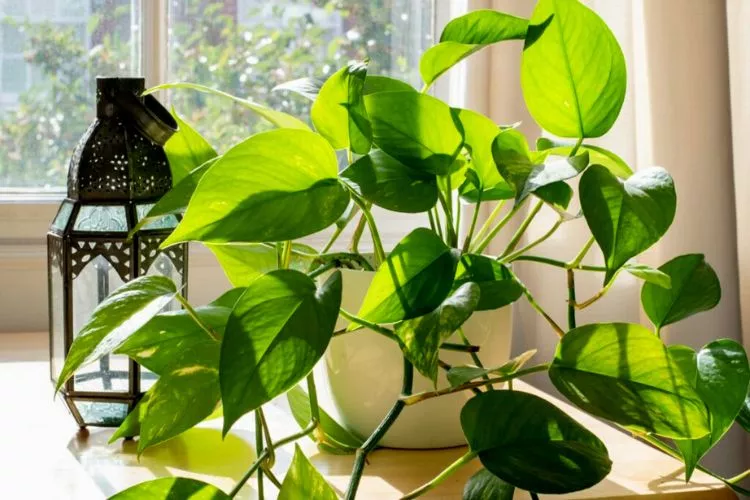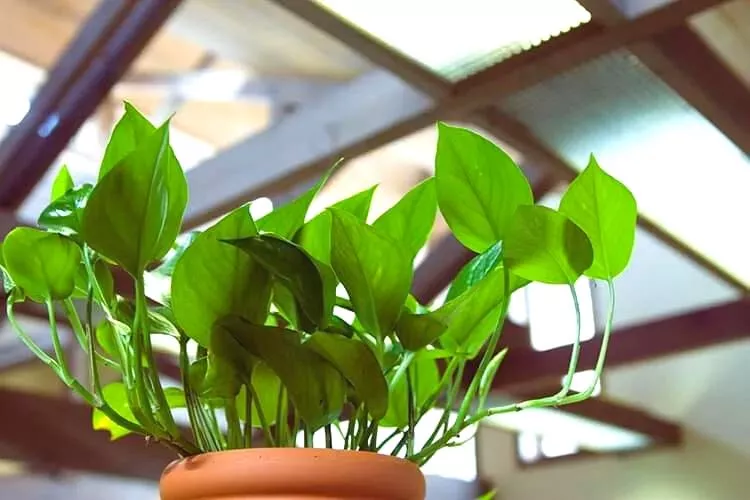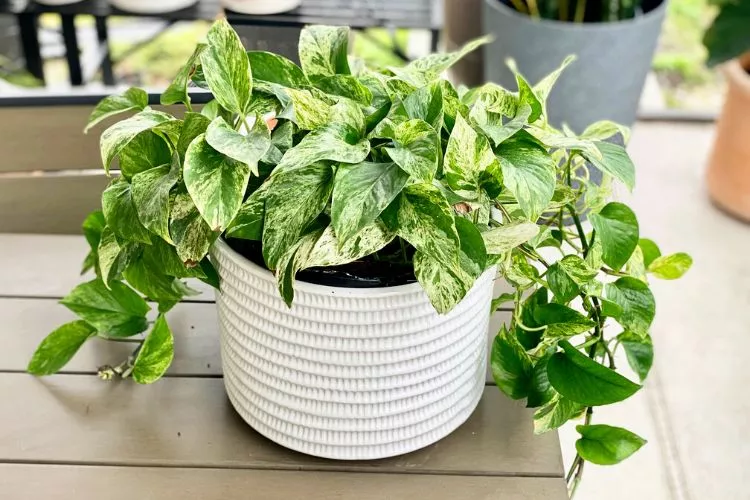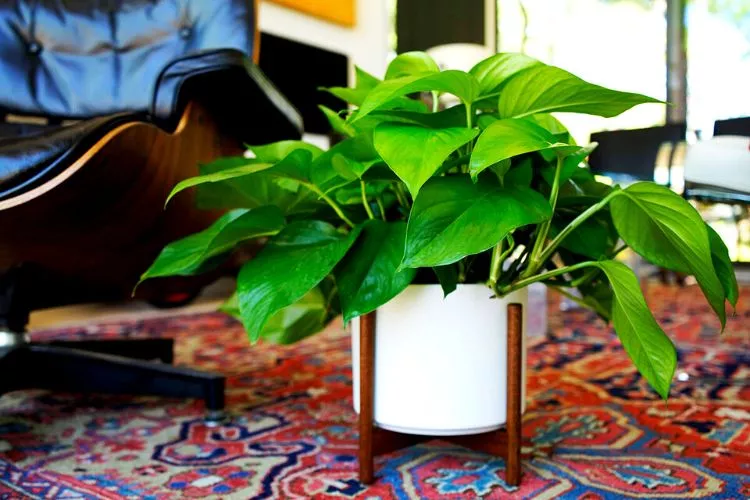Pothos plants have become increasingly popular among indoor enthusiasts for their low maintenance, air-purifying qualities and aesthetic appeal.
These hardy plants are versatile and can thrive in various indoor conditions. But, do pothos like humidity?
Well, humidity is a critical factor that can impact the growth and overall health of a pothos plant. It isn’t that they don’t like humidity, but it can affected if the humidity is too high to handle.
In this article, we will explore the relationship between Pothos plants and humidity, including ideal humidity levels, signs of stress, and tips for maintaining the appropriate humidity for a happy and healthy plant. Let’s dive in, shall we?

Table of Contents
Understanding Pothos Plants
Pothos plants are known for their attractive and glossy foliage, which comes in various colors, including green, yellow, and multi colored.
They are typically vining plants that can climb or trail, making them popular for hanging baskets or trained to grow on poles.

These fascinating plants are native to the tropical forests of Southeast Asia, where they thrive in warm, humid environments with filtered sunlight.
Several common Pothos plant varieties, including the Golden Pothos, Satin Pothos, Marble Queen Pothos, and Neon Pothos, each with unique leaf patterns and colors.
Do Pothos Like Humidity?
In short, Pothos plants like humidity but can be sensitive to excessive moisture levels. The ideal humidity range for a Pothos plant is between 40%- 60%. This amount mimics their native tropical environment. When a Pothos plant becomes stressed from high humidity, you will notice a few different symptoms. These include:
- Yellowing leaves
- Black spots
- Fungal growth.
In contrast, low humidity stress may present:
- Browning leaf edges
- Stunted growth.
Proper humidity levels are crucial for Pothos plants’ overall growth and health, as they affect transpiration rates, nutrient uptake, and pest susceptibility. You can maintain your plants’ optimal humidity levels using several methods. The most common include:
- Using a humidifier
- Misting the plant
- Grouping plants together
- Placing a tray of water near the plant
- Avoiding dry air sources.
It’s essential to regularly monitor the humidity levels. Either can achieve this:
- Using a hygrometer
- Adjusting levels based on season and weather changes
- Using well-draining soil
- Ensuring adequate airflow around the plant to avoid waterlogged roots and fungal growth.
9 Signs your pothos needs more humidity
The Pothos plant is a tropical plant that thrives in humid environments. However, signs of stress can occur when the humidity levels are too low.
Signs that your Pothos plant needs more humidity include wilting or dropping leaves, yellowing leaves, dry soil, brown leaf tips, dry brown circles, slow growth, a light pot, and a bad odor from the soil.
Properly maintaining humidity levels is crucial for your Pothos plant’s health and growth; taking action when these signs are present can help ensure a happy and thriving plant.
Here are 9 signs that your Pothos plant may need more humidity:

- Wilting Leaves: If your Pothos plant’s leaves are drooping, it may be a sign that it’s not getting enough moisture. This is especially true if the soil feels dry to the touch.
- Dropping Leaves: Pothos plants are known for being hardy, but dropping leaves may indicate a lack of humidity. When plants don’t get enough moisture, they shed leaves to conserve water.
- Leaves Turning Yellow: Yellowing leaves are another sign that your Pothos plant needs more humidity. This can happen if the plant is experiencing too much dry air, which can cause the leaves to lose moisture and fade in color.
- Dry Soil: If the soil around your Pothos plant feels dry, it may be a sign that it needs more water. Pothos plants prefer consistently moist soil; dry soil can cause stress and damage.
- Brown Leaf Tips: If the tips of your Pothos plant’s leaves are turning brown, it may indicate low humidity levels. This can happen when the plant is exposed to dry air for extended periods.
- Brown Dry Circles: If you notice brown, dry circles on your Pothos plant’s leaves, it may indicate too much direct sunlight or low humidity levels.
- Slow Growth: Pothos plants typically grow quickly in optimal conditions, but if your plant’s growth has slowed, it may be a sign of low humidity levels. The plant doesn’t seem to have enough moisture to convert the sunlight into food, hence the slowing growth.
- Pot Feels Light: If the pot feels light when you lift it, it may indicate that the plant needs more water. This is especially true if the soil feels dry to the touch. This can also mean the humidity levels are too low, causing drought.
- Bad Odor from Soil: A bad odor from the soil can be a sign of root rot, which can be caused by too much moisture. However, it can also be a sign of dry soil, as the lack of moisture can cause the roots to break down and produce an unpleasant odor. Dwindling moisture stores can mean levels of humidity are too low.
If you notice any of these signs, it’s essential to take action to improve the humidity levels around your Pothos plant.
Tips for Maintaining Humidity Levels for Pothos Plants
Properly maintaining humidity levels is crucial for the health and growth of your Pothos plant. To keep the humidity levels in the optimal zone, there are several tips you can take on board and implement.
These include avoiding overwatering, using a humidifier, misting the plant, grouping plants together, placing a tray of water near the plant, avoiding dry air sources, changing the potting soil, and using grow lights.
Let’s have a look at these helpful tips in a little more detail;

- Avoid Overwatering: Overwatering can cause waterlogged roots and contribute to sweating and high humidity levels. Be sure to allow the soil to dry out partially before watering.
- Using a Humidifier: A humidifier is a great way to increase the moisture levels in your indoor environment and maintain ideal humidity levels for your Pothos plant.
- Misting the Plant: Misting your Pothos plant with water effectively boost humidity levels around the plant. Never underestimate a couple of spritzes from a spray bottle.
- Grouping Plants Together: Grouping plants together can create a microclimate of higher humidity, particularly when plants are placed close together. This practice can either be utilized to increase the levels or thought about when the levels are too high. If they are high, the plants should be separated to prevent the levels from causing problems.
- Placing a Tray of Water Near the Plant: Placing a tray of water near the plant can help to increase the humidity levels by creating a small, localized source of moisture. Once the levels increase, simply remove the tray accordingly.
- Avoiding Dry Air Sources: Avoid placing your Pothos plant near sources of dry air or drafts, such as heating vents, air conditioners, and even doorways, which can cause low humidity levels.
- Changing the Potting Soil: Using a well-draining soil mix can help to prevent waterlogged roots and maintain healthy humidity levels for your Pothos plant.
- Using Grow Lights: Using grow lights can create a more tropical environment for your Pothos plant, which can help to maintain healthy humidity levels. The lights help to produce sweat, and any plants in the vicinity can also benefit.
By following these tips, you can help ensure your Pothos plant is healthy and happy in its indoor environment.
Pro Tips
In addition to the tips mentioned above, here are a few pro tips to help you maintain optimal humidity levels for your Pothos plant:
- Regularly Monitor Humidity Levels: Using a hygrometer to monitor humidity levels in your indoor environment is essential to ensuring that you maintain the right humidity level for your Pothos plant. The last thing you want is to get it to swing one way, but it continues in that direction and throws the plant out completely. It’s best to check the humidity levels regularly, especially during seasonal changes, to ensure that your plant receives the right amount of moisture.
- Adjust Humidity Levels Based on Seasonal Changes: The humidity levels in your home can vary significantly depending on the time of year. During the winter, the air tends to be drier, so you may need to increase the humidity levels around your Pothos plant to maintain optimal growth and health. Conversely, during the summer months, you may need to decrease humidity levels to prevent the plant from becoming too moist.
- Use a Well-Draining Soil Mix: Pothos plants prefer consistently moist soil but are not waterlogged. Using a well-draining soil mix can help prevent waterlogged roots and fungal growth, which can contribute to poor humidity levels and overall plant health.
- Provide Adequate Airflow: Proper airflow around your Pothos plant prevents moisture buildup and fungal growth. Avoid placing the plant in a stagnant or closed-off area, as this can cause low humidity levels and poor growth.
- Avoid Cold Drafts: Pothos plants are tropical and prefer temperatures above 60°F (15°C). Cold drafts can cause stress and shock the plant, leading to lower humidity levels and poor growth.
Frequently Asked Questions (FAQs)
Can Pothos live in a bathroom without windows?
Yes, Pothos can live in a bathroom without windows, as they tolerate low light conditions. However, without natural light, you may need to provide some artificial light or supplement the plant’s needs with appropriate fertilization to ensure healthy growth.
Should I bottom water my Pothos?
Yes, bottom watering is a recommended method for watering Pothos plants as it ensures the roots receive water and can prevent overwatering. It involves filling a tray with water and allowing the plant to absorb it from the bottom up.
Do Pothos like to be root bound?
While Pothos can tolerate being slightly root-bound, they don’t like it. When root-bound, they may exhibit stunted growth, smaller leaves, or reduced overall health. It is recommended to repot Pothos plants every 1-2 years to ensure healthy growth.
Conclusion:
In conclusion, maintaining the right humidity levels for your Pothos plant is crucial for its growth and overall health. Signs of low humidity stress can be avoided using several methods, including a humidifier, misting the plant, and grouping plants together.
Additionally, it’s important to use well-draining soil, provide adequate airflow, and monitor humidity levels regularly.
We hope this guide has helped us understand the importance of humidity for Pothos plants, and we encourage you to care for your plant by following the tips provided. For more helpful guides on indoor plants, check back on our website soon.


